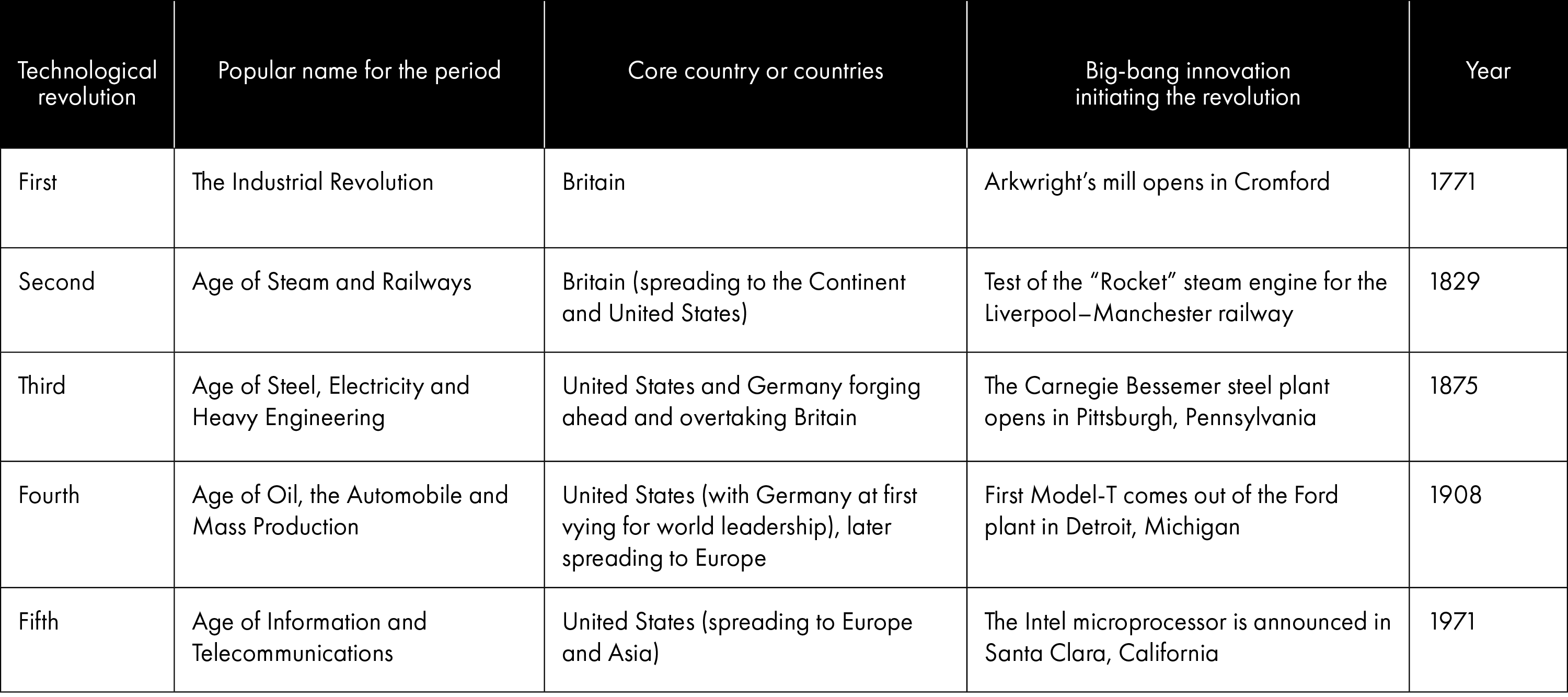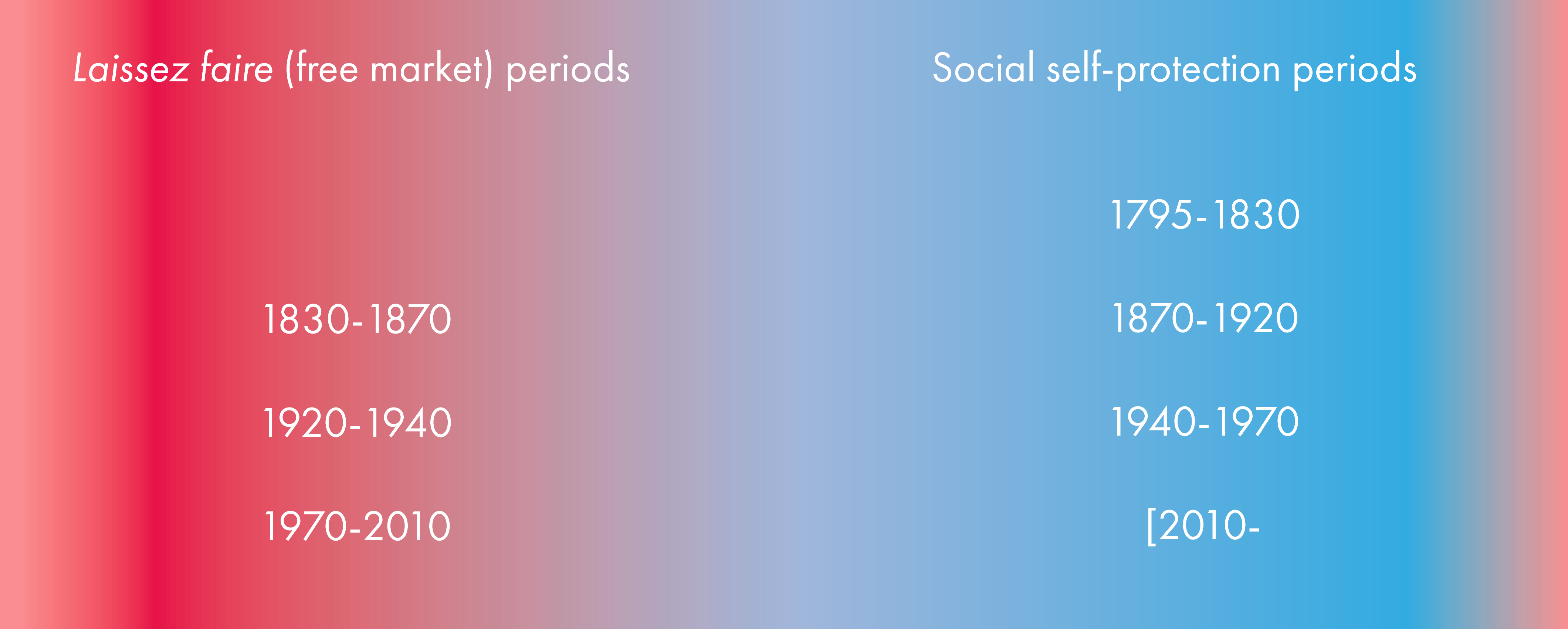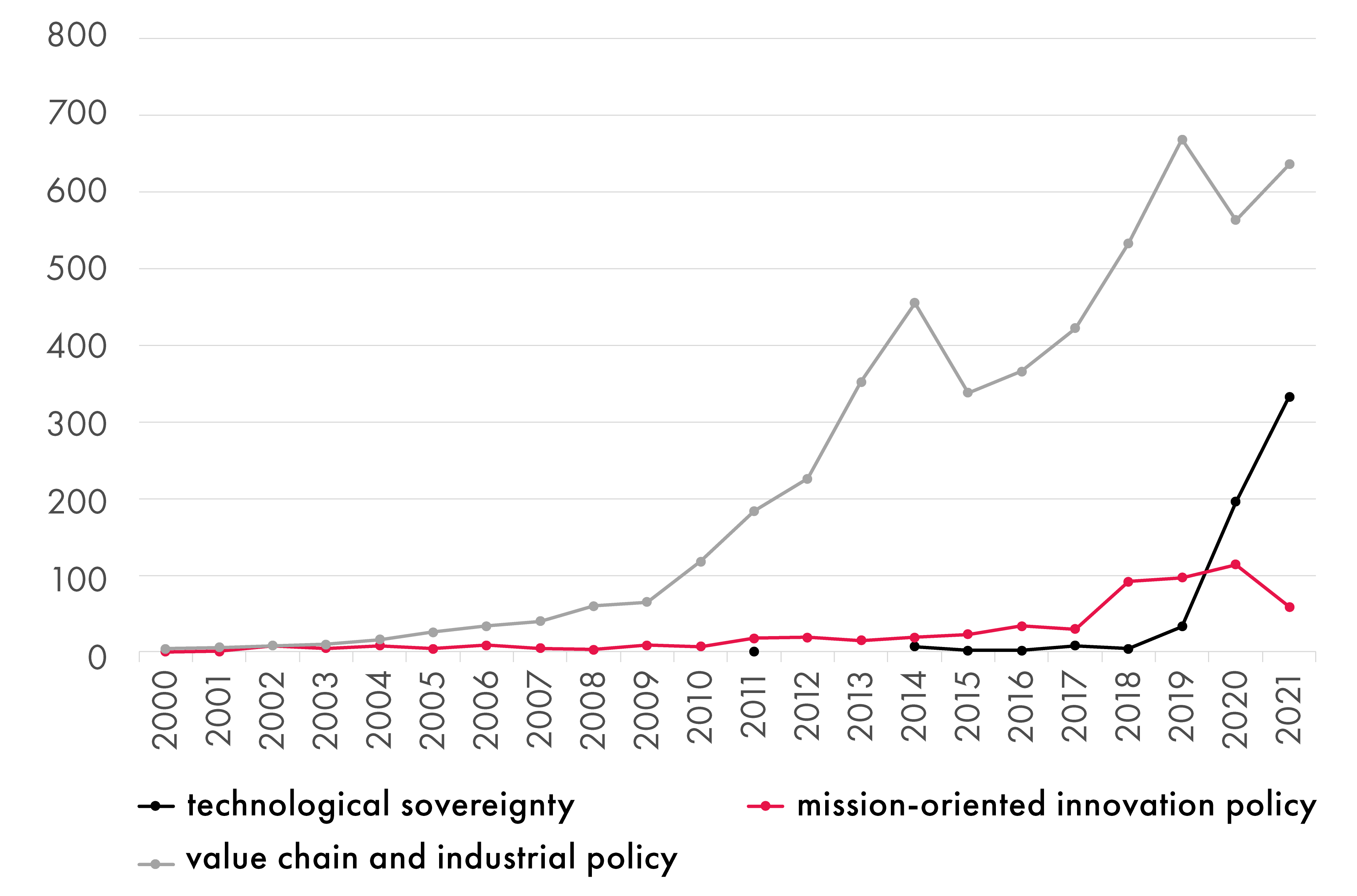Introduction
The view that the role of the state in the economy is constant over time clashes with reality. Usually, those who perceive the state’s economic role as static espouse a theoretical view that states should intervene as little as possible in markets, except to correct occasional “market failures” in order to allocate resources efficiently. From a historical perspective, this constant, hands-off governmental1 approach is apocryphal. What can be observed is a changing role of the state, which varies with the cyclical surges of technological change as well as of geopolitical (and ideological) inclinations. This conference paper discusses the former: how the role of the state changes along the life cycle of a technological revolution while also taking into account the latter.
Several scholars propose different ways to conceptualize the evolution of technical change in terms of technological or industrial eras. One approach is to contrast the technological developments since the eighteenth century, which came to define our current era of “industrial modernity” with the ways that society organized itself and the economy in the preceding (mostly) agrarian era (Brynjolfsson and McAfee 2014; Schot and Kanger 2018). Another approach does not see the post-Industrial Revolution period as monolithic but identifies successive “long waves” of industrial or technological “revolutions” (Perez 2002; Schwab 2016, viii). These revolutions would follow distinctive and recurrent patterns of emergence, diffusion and consolidation, yet creating unique impacts on established structures (Perez 2002). Schot and Kanger (2018) provide a periodization that actually could be seen as a bridge between both approaches: in their view, the several technological revolutions of the past three centuries represent a first “deep transition” (from the agrarian era to industrial modernity) and we would be witnessing, due to a wave of breakthrough renewable energy technologies and green innovations (powered by disruptive digital technologies), the emergence of a second deep transition — this time, from industrial modernity to sustainable post-modernity. Despite their distinct perspectives on the cyclical nature of capitalist technological development, these authors tend to agree that the wave of digital innovation from the past 40 years has created challenges and opportunities — for incumbent firms, industries, regions and whole nations — posing new demands for the role of the state, particularly in relation to the governance of disruptive digital technologies.
My discussion of the role of the state is based on the periodization of technological revolutions proposed by Perez (2002) because of its comprehensiveness, level of conceptual detail and coherence, which provides a compelling picture of the long-term dynamics of capitalist technological development. Working in the neo-Schumpeterian long-wave (or Kondratiev cycle2) tradition, Perez (ibid.) identifies five technological revolutions, each triggering “great surges of development” (GSD) (see Table 1): “the process by which a technological revolution and its paradigm[3] propagate across the economy, leading to structural changes in production, distribution, communication and consumption as well as to profound and qualitative changes in society” (ibid., 15). Perez (ibid.) sees the emergence and diffusion of each GSD as divided into two: initially, the emergence of a new revolution is led by financial capital, while, in the second half of the process, diffusion of the revolutionary innovations is promoted by the state (I will return to and detail this conceptualization in the section titled “The Perezian Techno-economic Cycle”).
Table 1: Five Great Surges of Growth and Five Major Technology Bubbles

The second conceptual anchoring for the discussion of the role of the state in the process of technological development is the notion of a “double movement” in capitalism, proposed by Polanyi (2001): the idea that contradictory forces govern capitalist development in a dialectical process (Fiori 2004). One force is based on liberalizing principles that promote the expansion of free markets; the other is based on social self-protection principles that keep this expansion constantly in check to protect society from the “ravages of this [free market] satanic mill” (Polanyi 2001, 73). While such forces are always in operation, they come to the fore and subside in different historical moments, so that Polanyi’s double movement can also be interpreted as a secular pendulum (Kretschmer 2019; Nölke and May 2019; Stewart 2010). Perez’s (2002) theory seems consistent with Polanyi’s double movement: indeed, I will argue that Perez (ibid.) offers an explanation of Polanyi’s political-economic double movement in terms of technological dynamics.
Against this background, I shall discuss two interrelated propositions:
- From a Polanyian perspective, since the 2000s, the world has moved toward a period of a proactive role of the state, most visible in the level of political and policy discourse (but also increasingly put into action).
- From a Perezian perspective, this new proactive role calls for specific regulations and investments to address technological externalities and social inequalities caused by and associated with the digital technologies of the fifth technological revolution (which is yet to be put into action).
The conference paper4 is structured around these two propositions (sections titled “The Polanyian Pendulum” and “The Perezian Techno-economic cycle,” respectively), and concludes with a discussion of the implications for the prospects of global cooperation on digital governance.
The Polanyian Pendulum
Karl Polanyi (2001, 3–4) introduces his thesis of a capitalist “double movement” in the beginning of the first chapter of The Great Transformation: “Our thesis is that the idea of a self-adjusting market implied a stark Utopia. Such an institution could not exist for any length of time without annihilating the human and natural substance of society; it would have physically destroyed man and transformed his surroundings into a wilderness. Inevitably, society took measures to protect itself, but whatever measures it took impaired the self-regulation of the market, disorganized industrial life, and thus endangered society in yet another way.”
Only in chapter 8 does Polanyi refer to this dynamic as a double movement and, later, in chapter 11, he explains that whenever “the market expands itself continuously […] this movement [is] met by a countermovement checking the expansion in definite directions” (ibid., 130). Polanyi’s double movement represents a constant dialectical process: “the two principles have material and social roots that coexist in a necessary, permanent and contradictory way within capitalism” (Fiori 2004, 60 [my translation]). Indeed, in the history of capitalism, the state was and is responsible for establishing rights and duties that define the limits of the free market (Chang 2002). The liberal market itself is embedded in social, political and cultural institutions (Granovetter 1985) that define its boundaries of free action, such as law and public order, execution of contracts, property rights, public goods, conditions of business conduct and economic regulations. Polanyi (2001, 140) is adamant that even in England, the cradle of capitalism, the free-market economy (what the author calls “laissez-faire economy”) was produced by the deliberate action of the state: “The road to the free market was opened and kept open by an enormous increase in continuous, centrally organized and controlled interventionism.”
The capitalist double movement is often also interpreted as a secular pendulum, an idea that is rooted in Polanyi’s insight that “various countries of a widely dissimilar political and ideological configuration...each…passed through a period of free trade and laissez-faire, followed by a period of antiliberal legislation in regard to public health, factory conditions, municipal trading, social insurance, shipping subsidies, public utilities, trade associations, and so on. It would be easy to produce a regular calendar setting out the years in which analogous changes occurred in the various countries” (ibid., 147). This insight resulted in a stream of research that sought to identify the periods of laissez faire and the periods of interventionism. While the specific dates differ, the periods seem largely to coincide. Drawing on Burawoy (2010), Kretschmer (2019), Nölke and May (2019), and Stewart (2010), a periodization can be established for the Polanyian pendulum between the late eighteenth century and the early twenty-first century (Figure 1). Of course, the dates are approximate, because the forces are always in operation (it is a dialectical process), each slowly moving to the foreground or to the background (until certain events may catapult one or the other to prominence).
Figure 1: The Swings of the Polanyian Pendulum

While the identification of the first three periods of “social self-protection” and of laissez faire are based on an interpretation of those works, here I propose that the fourth period of social self-protection has started somewhen around 2010, or after the global financial crisis (GFC) of 2007–2008. To be sure, this “new swing of the Polanyian pendulum” is discussed by other authors, such as Fiori (2004) and Kaldor (2018), who discuss a new “realist” period in the geopolitical dynamics. In this conference paper, I will, however, concentrate on the role of the state in the technological process and, therefore, in terms of innovation (and industrial) policy and regulation.
In Penna (2021), I argued that the coronavirus disease 2019 (COVID-19) pandemic magnified those interrelated geopolitical and techno-economic trends, claiming that:
- The manufacturing global value chains overly dependent on China would eventually be a central target of national policy, which would aim at making the country’s economy less dependent on Chinese imports.
- Upgrading industrial structures and reshoring of value chains would become “the flavour of the month” in the policy makers’ menu of measures, i.e., a return to active industrial policy.
- Industrial and innovation policies would increasingly be “mission-oriented” (Mazzucato and Penna 2015), i.e., aimed not only at seizing technological opportunities associated with the new wave of disruptive digital technologies, but also at contributing to the solution of urgent societal challenges (such as mitigating climate change or caring for an aging population).
- As a consequence of the US-China technological and geopolitical competition, the policy space for multilateral governance of digital technologies would be diminished.
These speculations were a logical conclusion from the observed empirical trends (while also explained from the theoretical perspective of political economy). The new activist role of the state in innovation and technological policy is most visible in the policy discourse, as indicated by the number of governmental publications discussing how to ascertain “technological sovereignty” and make economies and value chains more resilient, while also focusing industrial and innovation strategies on the achievement of missions (Figure 2).5
Governmental attention to industrial policy seems to have increased substantively in the aftermath of the GFC, reaching a peak in 2019, which is likely to be surpassed in 2021. Mission-oriented innovation policy received an impetus in 2018, which coincided with the publication of the European Commission’s “Mazzucato Report” (Mazzucato 2018). The catalyst effect of the COVID-19 pandemic seems most evident in the case of governmental attention to “technological sovereignty,” which was not mentioned in governmental documents in the Overton database before 2014 (except for one European Parliamentary Research Service report in 2011 on the impact of the GFC on European defence).
Figure 2: Government Documents Citing Technological Sovereignty, Mission-Oriented Research and Innovation, and Industrial Policy (2000–2021)

Concern with technological sovereignty at the EU level predates the pandemic (which is visible in Figure 1) and was triggered in 2019 by European Commission President (then elected) Ursula von der Leyen, who made the issue a priority in her presidential term (Cunningham 2020). Such prioritization of technological sovereignty will likely continue when France takes over the rotating presidency of the European Commission in January 2022, given French President Emmanuel Macron’s recent declarations (Macron, quoted in Kayali 2021)6 on the need to ensure Europe’s “digital” and “technological” sovereignty. Macron also announced in October 2021 France’s own €30 billion technological and industrial plan to ensure the country’s domination of digital, robotic and genetic technologies. On the other side of the Atlantic, US President Joe Biden’s industrial and infrastructure plan can also be seen as a techno-economic sovereignty strategy that seeks to ensure the United States has the “most resilient, innovative economy in the world.”7 Both the (French and US) plans are also “mission oriented,” as they seek to address climate change and other societal challenges.
These political discourses and policy plans expose a tension between the interests and strategies of different countries in terms of technological sovereignty, while revealing a new approach to the role of the state in the innovation process. This tension was evident in the beginning of the COVID-19 pandemic, when countries were holding back medical supplies for themselves: from China (O’Keeffe, Lin and Xiao 2020)8 restricting exports of masks and other medical goods, to the United States supposedly “hijacking” (Ankel 2020; O Globo 2020) medical equipment shipped to third countries through US territory. These episodes show that, when a crisis looms, the actions of national governments suddenly become “realist” and any traces of the “liberal” international relations’9 rhetoric disappear: the nation-state and the interests and welfare of their citizens become the privileged frame of reference. But beyond the rhetoric of the political discourse and the action of active investments in new industries and technologies, what is the new role of the state in the governance and regulation of digital technologies? To address this question, we look at the Perezian techno-economic cycle (Perez 2002).
The Perezian Techno-economic Cycle
Perez (ibid., 36) calls the first half of the GSD the “installation period,...when the new technologies irrupt in a maturing economy and advance like a bulldozer disrupting the established fabric and articulating new industrial networks, setting up new infrastructures and spreading new and superior ways of doing things”; and the second half “the deployment period,...when the fabric of the whole economy is rewoven and reshaped by the modernizing power of the triumphant paradigm, which then becomes normal best practice, enabling the full unfolding of its wealth generating potential.”
Based on a historical analysis of the five surges, she further argues that, on the one hand, installation is led by financial capital, which thrives in free markets, while, on the other hand, deployment is promoted through state activism that supports production capital. This is the reason why the role of the state changes alongside a technological revolution: from a non-interventionist approach to the economy, facilitating entrepreneurial experimentation fuelled by financial capital, to a proactive leading role, promoting institutional change and investments to regulate negative externalities caused by new technologies, addressing inequalities and income polarization, and further supporting technological diffusion. Toward the end of a GSD, the role of the state becomes entrepreneurial itself, with public investments creating the very inventions that provide a fertile soil for the private entrepreneurial activity that will trigger the next technological revolution and GSD. This is the “entrepreneurial state” that Mazzucato (2013) talks about. What Perez does is to offer an explanation of the political-economic double movement identified by Polanyi that is linked to technological dynamics.
From the Perezian perspective, the new role of the state calls for an active approach to promote institutional changes (new laws and regulations), in order to address technological externalities and social inequalities caused by and associated with the digital technologies of the fifth technological revolution (or GSD). Or, to put it in a Polanyian “language”: to protect society from the ravages of the free-market “satanic mill.” In the fourth GSD — that of the automobile and mass production — the institutional recomposition and state activism started with then US president Franklin Roosevelt’s New Deal and, more crucially, with the new financial architecture provided by the Bretton Woods system. (The European reconstruction initiative known as the “Marshall Plan” can also be seen as part of this process, as can the developmental policies of Latin American and Asian countries).
In the fourth GSD, taming the externalities of the paradigm-carrying US automobile industry — the industrial sector that produces and disseminates the core technological innovation of the revolution, and thus establishes the “best practice” principles (i.e., the techno-economic paradigm) — required the establishment of new laws, which culminated with, for example, the US National Traffic and Motor Vehicle Safety Act of 1966, which established mandatory safety standards for automobiles, and the US Clean Air Act of 1970, which mandated that automobiles would have to comply with stringent emission levels for carbon monoxide, nitrogen oxides and hydrocarbons (Penna 2014). These laws established a new technological governance framework that further underscored the proactive role of the state in the second half of the fourth technological revolution (i.e., from the 1940s to the 1970s). It is such a technological governance framework that is absent from the current pro-state rhetoric, which mostly focuses on governance and regulatory aspects to assure technological sovereignty (with the notable exception of the case of data privacy10).
Conclusion: Implications for Global Governance of Digital Technologies
Nowadays, the widespread diffusion of digital technologies is bringing about negative externalities in the form of disruption of established structures (work relations, business models, trade patterns). This potential disruption calls for a realignment of institutions and the establishment of a new governance system. Digital technologies result in many different types of issues, each creating a new demand for technological governance (Instituto Euvaldo Lodi et al. 2017):
- ethical (for example, the right to privacy and data confidentiality);
- proprietary (for example, ownership and access to data);
- industrial design (for example, the degree of autonomy of machines, which could become an issue of economic and political power);
- normative (for example, the establishment of open versus proprietary standards and of technical standards for tracking decisions, securing compatibility and retrofitting legacy systems);
- techno-economic (for example, support for the development of technical and organizational skills adapted to each production system); and
- socio-environmental (for example, rising unemployment due to robotization or the disposal of digital equipment, supplies and goods).
All such problems call for a new regulatory role of the state, and some of them may not be amenable to national regulations — they need a global framework if the problems are to be effectively addressed. Former US president Donald Trump’s discourse of distrust over the action and mandates of existing multilateral institutions (and threat to leave the World Health Organization and World Trade Organization) was at odds with the prospects of international agreements in the regulation of the digital economy. While it is expected that Biden will resort to a cooperative rhetoric, this benevolent discourse will likely disguise real action to safeguard the interests of the United States.
As I discuss in the section titled “The Polanyian Pendulum,” the current scenario is defined by increased realism in international relations, whereby nation-states will increasingly act to guarantee their own (economic, political, technological) sovereignty. The US-China technological and geopolitical competition that came to the fore of the global stage in the Barack Obama era and became most evident (until now) during the Trump years already indicated a diminishing policy space for multilateral governance of digital technologies (Penna 2021). The Annual Security Policy Forecast for 2021 by the Austrian Ministry of National Defence makes a scenario assessment that concludes that “the global strategic environment is moving towards deterioration into a fragmented, confrontational international environment with decreasing possibilities of steering at the global and regional levels” (Richter 2021, 55). Indeed, in this scenario, multilateralism tends “to assert the interests of the apparently benevolent liberal US hegemon” (Jedlaucnik 2021, 67).
In terms of digital technologies governance, what may be seen is a dispute between competing technological standards at the global level, for instance, for fifth-generation telecommunications technologies, but also for blockchain standards, data protection regulations or Internet of Things, for example. While a technological-standard tug of war between the United States and China is obvious, with the former trying to ascertain its techno-industrial prowess (and keep its status as technological leader) and the latter trying to advance its techno-industrial capabilities (and go beyond its status as the world’s manufacturing powerhouse to challenge the US technological leadership), we may also see the emergence of a European way for technological governance of digital technologies.
It was during the twentieth-century Cold War between the United States and the Soviet Union that the world witnessed the “golden age” of capitalism — a period of widespread global welfare that Perez (2002) sees as a possibility for every second half of a technological revolution, as long as there is an adequate institutional framework to address the issues created in its first half. Thus, it could well be that during the current swing of the Polanyian pendulum we see a new global golden age. Yet, for that to happen, the role of national states will have to go beyond assuring narrowly defined technological sovereignty plans and promote a new institutional architecture that addresses the negative consequences of technologies and the socioeconomic inequalities at the global level.



